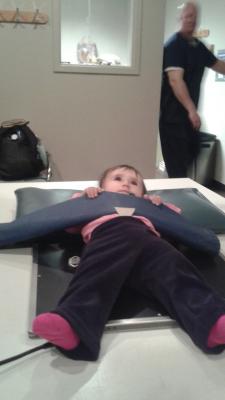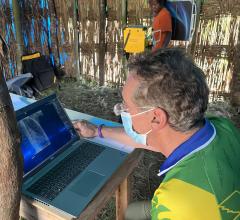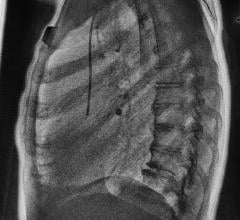
Gonadal shielding (triangular plate) of a toddler undergoing a hip X-ray to reduce the radiation dose to the patient.
January 3, 2017 — The use of a flat contact shield during imaging of the adult male pelvis can result in statistically significant radiation dose reduction to the testes, according to a recent study published in the journal Radiologic Technology.
Conducted by Terri L. Fauber, Ed.D., R.T.(R)(M), a professor emeritus of radiation sciences at Virginia Commonwealth University in Richmond, Virginia, the study shows a 36.4 percent increase in exposure to the testes was calculated when no contact shield was used during pelvic imaging. As a result, Fauber concludes the routine practice of shielding adult male gonads during radiographic imaging of the pelvis should be a best practice for all radiographers.
Fauber first completed a literature review to identify historical trends in shielding radiosensitive organs. The literature review showed a wide disparity of opinions on the use of gonadal shielding. “The effectiveness of gonadal shielding has been a debated topic in clinical practice for many years and it continues today with just as much zeal,” Fauber said. “I was surprised to find the literature also debated the efficacy of gonadal shielding. As a result, I was compelled to further explore the topic.”
To determine whether shielding reduces radiation exposure to the gonads, Fauber used a male anthropomorphic phantom equipped with holes for placement of thermoluminescent dosimeters to correspond to the testes. A flat contact shield was used to shield the phantom’s testes. Ten exposures were made of the pelvis with and without shielding. The exposed TLDs were then analyzed by the University of Wisconsin Calibration Laboratory, which reported the radiation exposure readings for the TLDs with and without shielding.
The study notes that the findings are at odds with previous research that concluded radiation exposure to the testes is not significantly reduced by the use of flat contact shielding. However, Fauber’s findings lend support to a 2010 study that showed that radiation exposure to the testes can be reduced significantly when using a flat contact shield.
“Because there are uncertainties regarding the biologic risks of low-dose radiation exposure, gonadal shields should be consistently utilized and accurately placed,” Fauber said. “In addition it’s good radiation hygiene, especially as our patients become more knowledgeable about potential risks of radiation exposure.”
Fauber said that very little research exists regarding the attitudes of radiologic technologists toward the importance of gonadal shielding and self-reported practices. A large study in the United States on self-reported knowledge about the efficacy of gonadal shielding and its routine practice would provide important information on shielding as a radiation safety practice. Investigating the effectiveness of staff training on the practice of correctly shielding the gonads also would provide valuable information to encourage radiographers to use gonadal shielding routinely.


 April 09, 2024
April 09, 2024 








